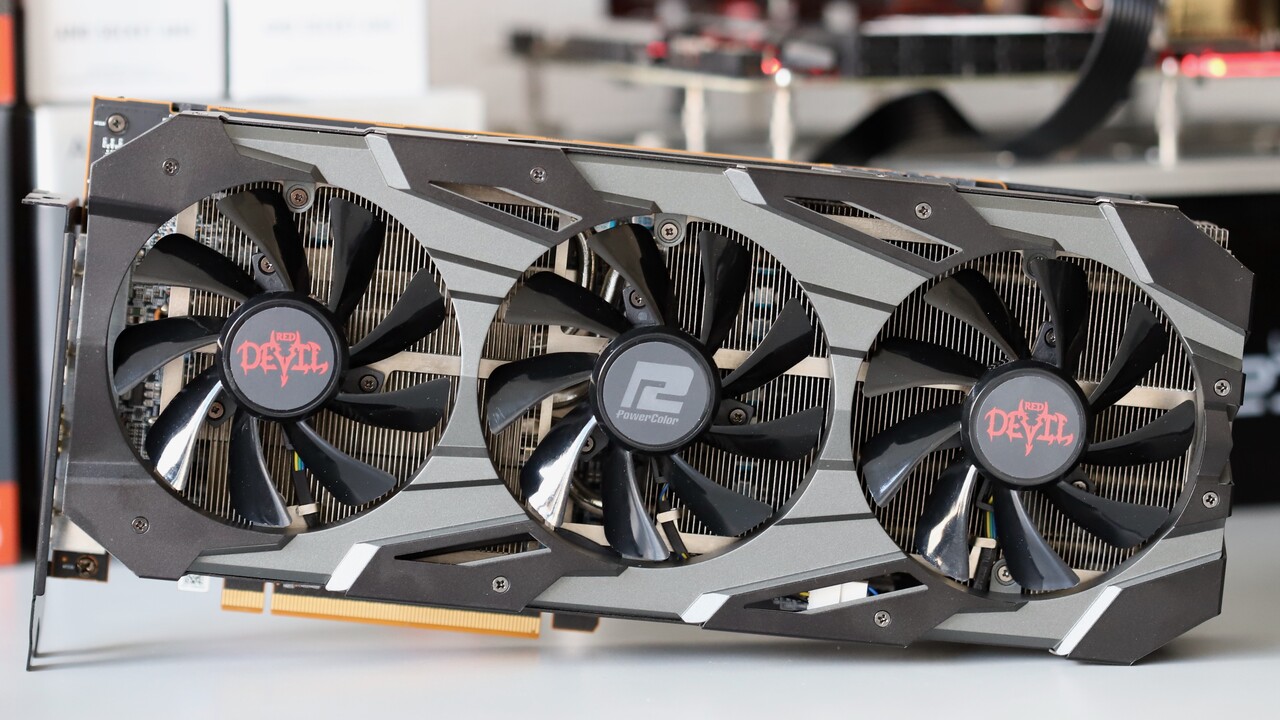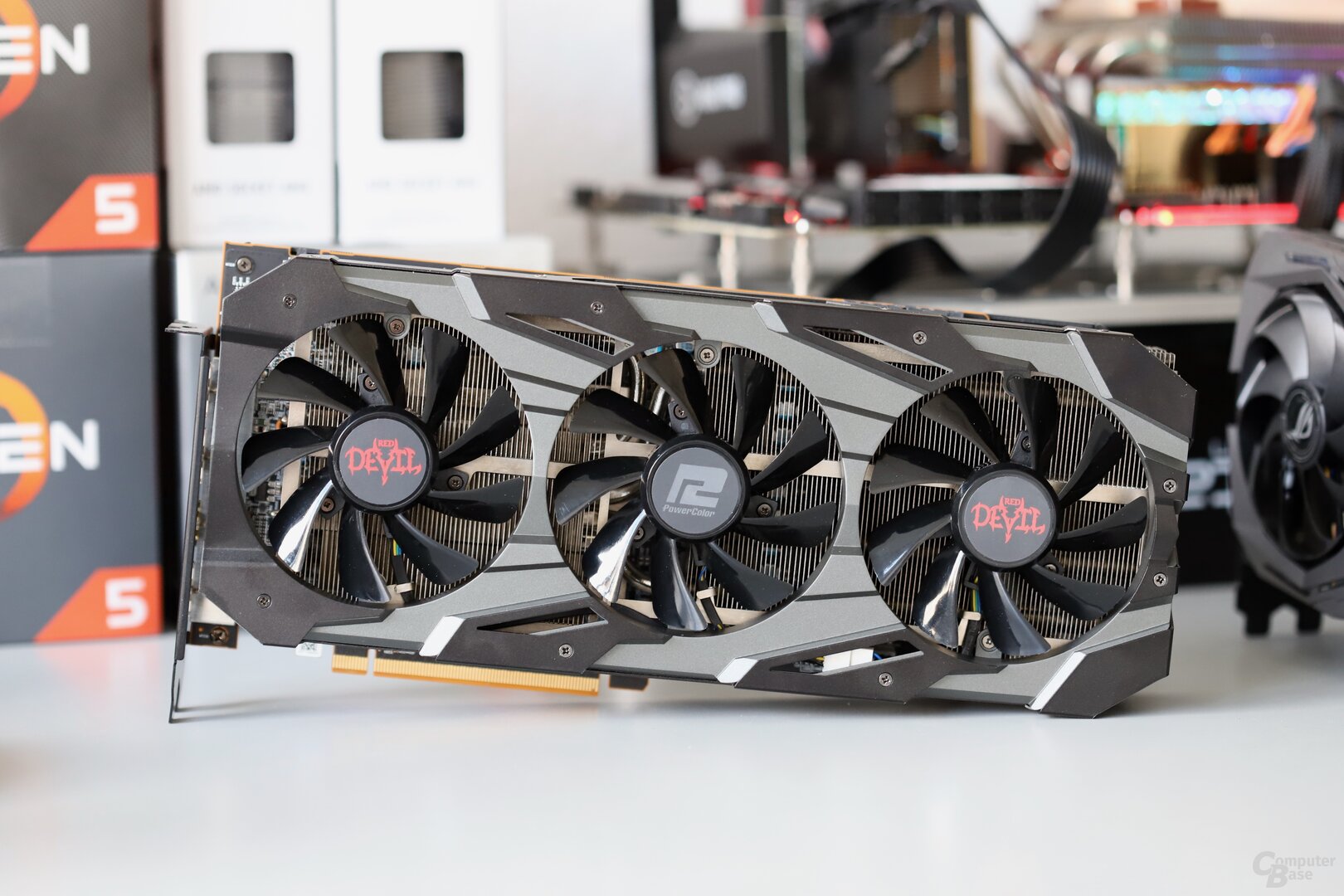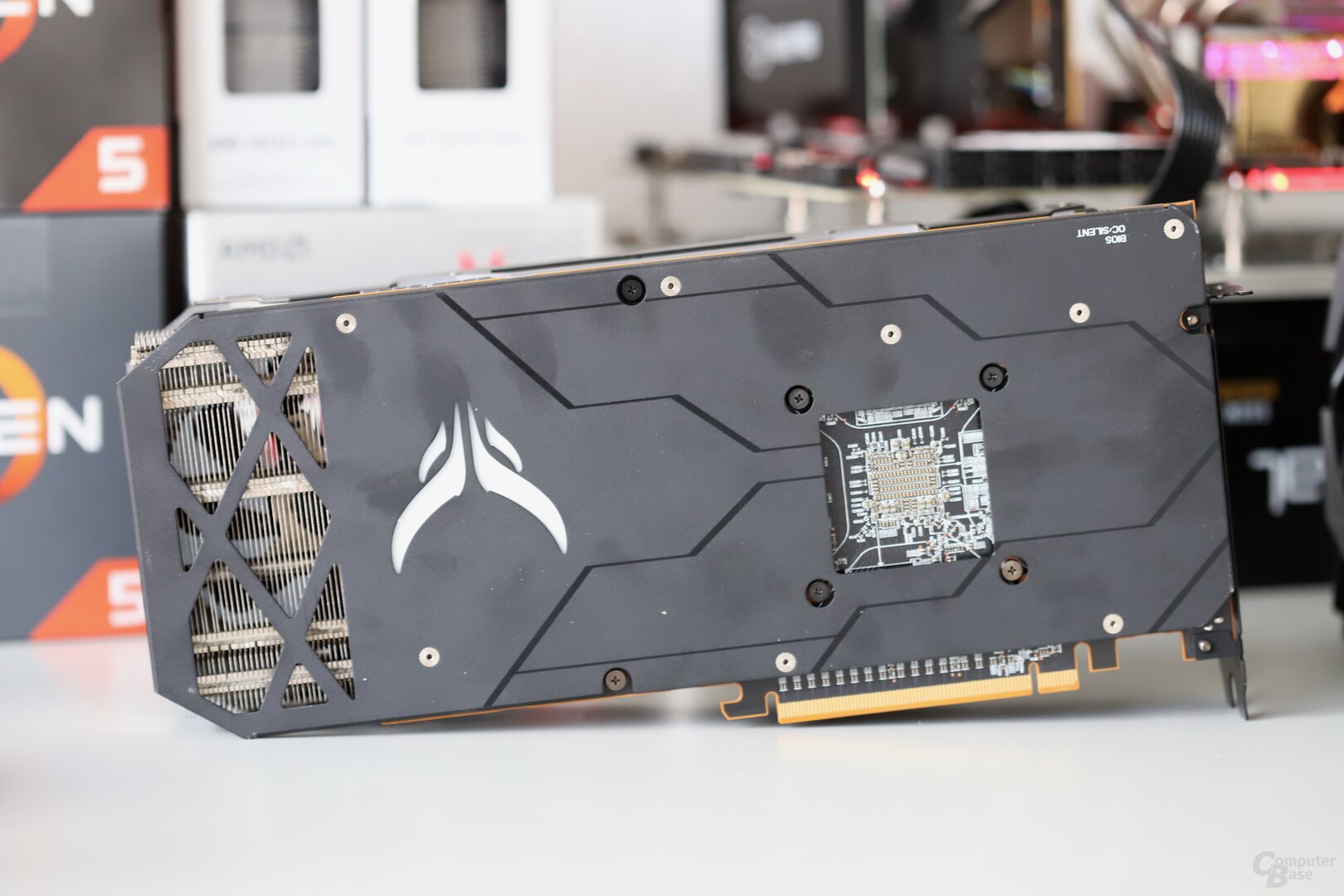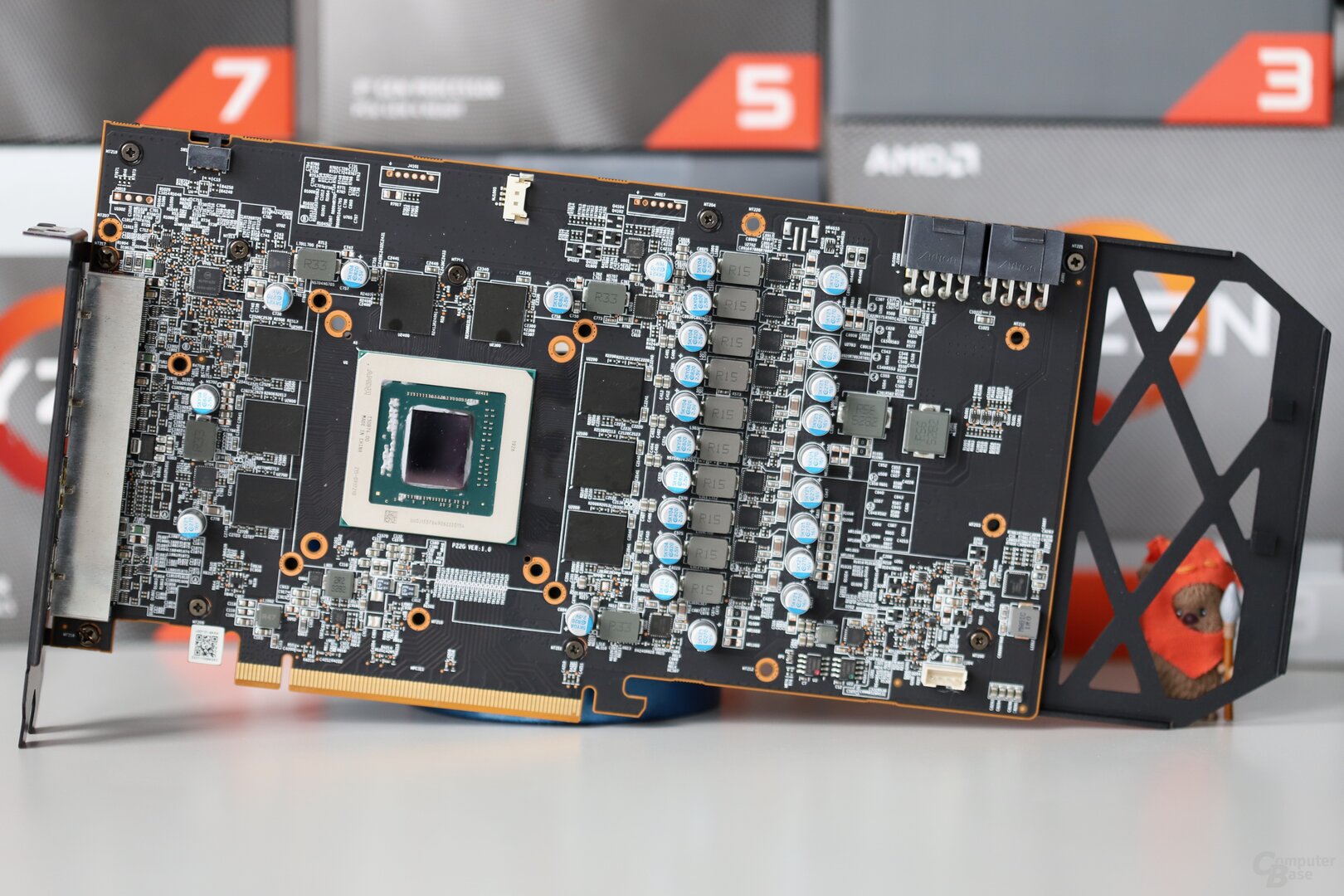– PowerColor is in full swing with the Navi 10 top model Radeon RX 5700 XT Red Devil and relies on a massive cooler, new RGB lighting and two different BIOS versions. Even on paper, the model has what it takes to be the best Navi custom graphics card. The price speaks for it.
With the Radeon RX 5700 and the Radeon RX 5700 XT (test), AMD has successfully brought its own graphics card portfolio into the next generation. RDNA works much better than the old GCN. However, one thing has remained the same: the loud reference cooler. And so many interested parties have been waiting for the so-called custom designs since July 7th.
PowerColor Red Devil: A top model at the "entry price"
While the Sapphire Radeon RX 5700 XT Pulse and the XFX Radeon RX 5700 XT THICC2 want to offer an affordable entry into the navigation world in their respective portfolios, the Asus Radeon RX 5700 XT Strix OC appeals to enthusiasts. PowerColor stands in exactly the same notch with the Radeon RX 5700 XT Red Devil, which is entering the race for the best custom graphics card of the Navi generation with a large cooler, two rather different BIOS versions and a completely new RGB lighting for PowerColor , There is still a positive surprise with the price.
PowerColor has a suggested retail price for the Radeon RX 5700 XT Red Devil from 449 euros. That would mean a surcharge of only about 50 euros compared to the current retail prices for AMD's reference card and corresponds to the MSRP for the Pulse version of Sapphire. For Asus Strix OC, however, suggests a price that is more than 100 euros higher.
The PowerColor Radeon RX 5700 XT Red Devil in detail
The Radeon RX 5700 XT Red Devil is available in two versions: In addition to the standard version, there is also a limited edition. The graphics card itself is identical, but the “LE” has more elaborate packaging with a large box and a mouse pad. There are no other differences. The normal variant will cost 449 euros, the limited edition 459 euros. First, the limited edition will appear in stores and then be replaced by the standard version after a very short time.
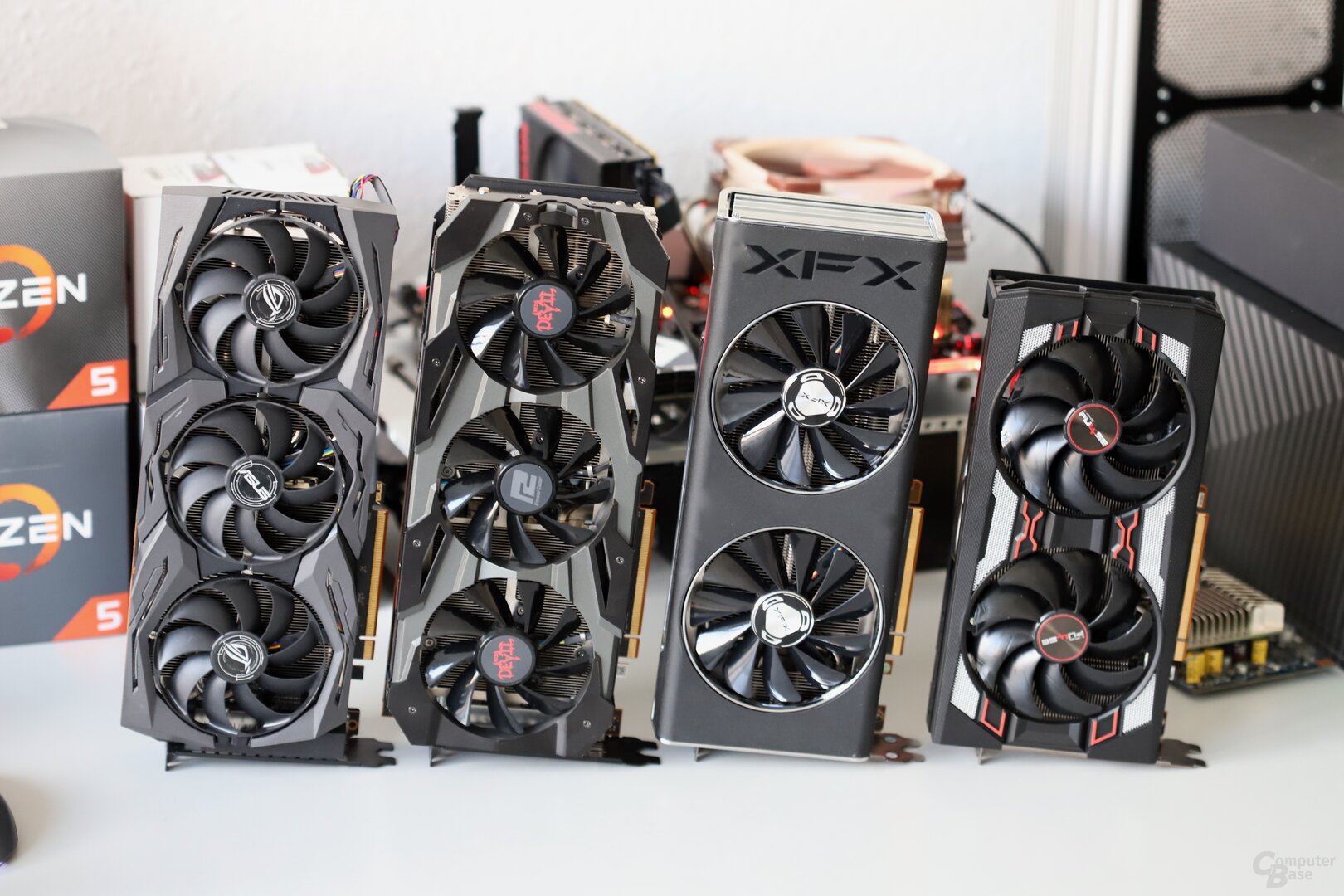
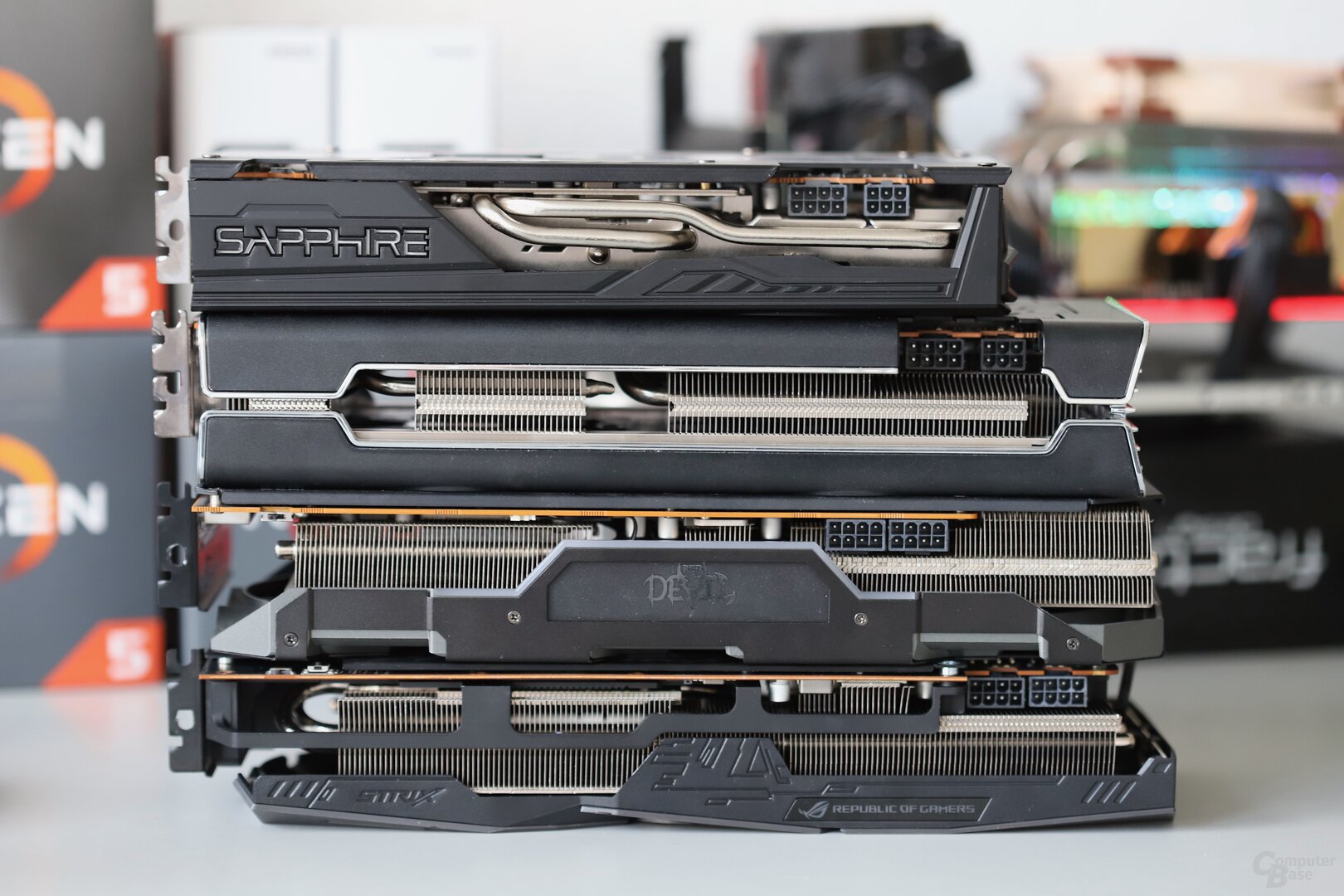
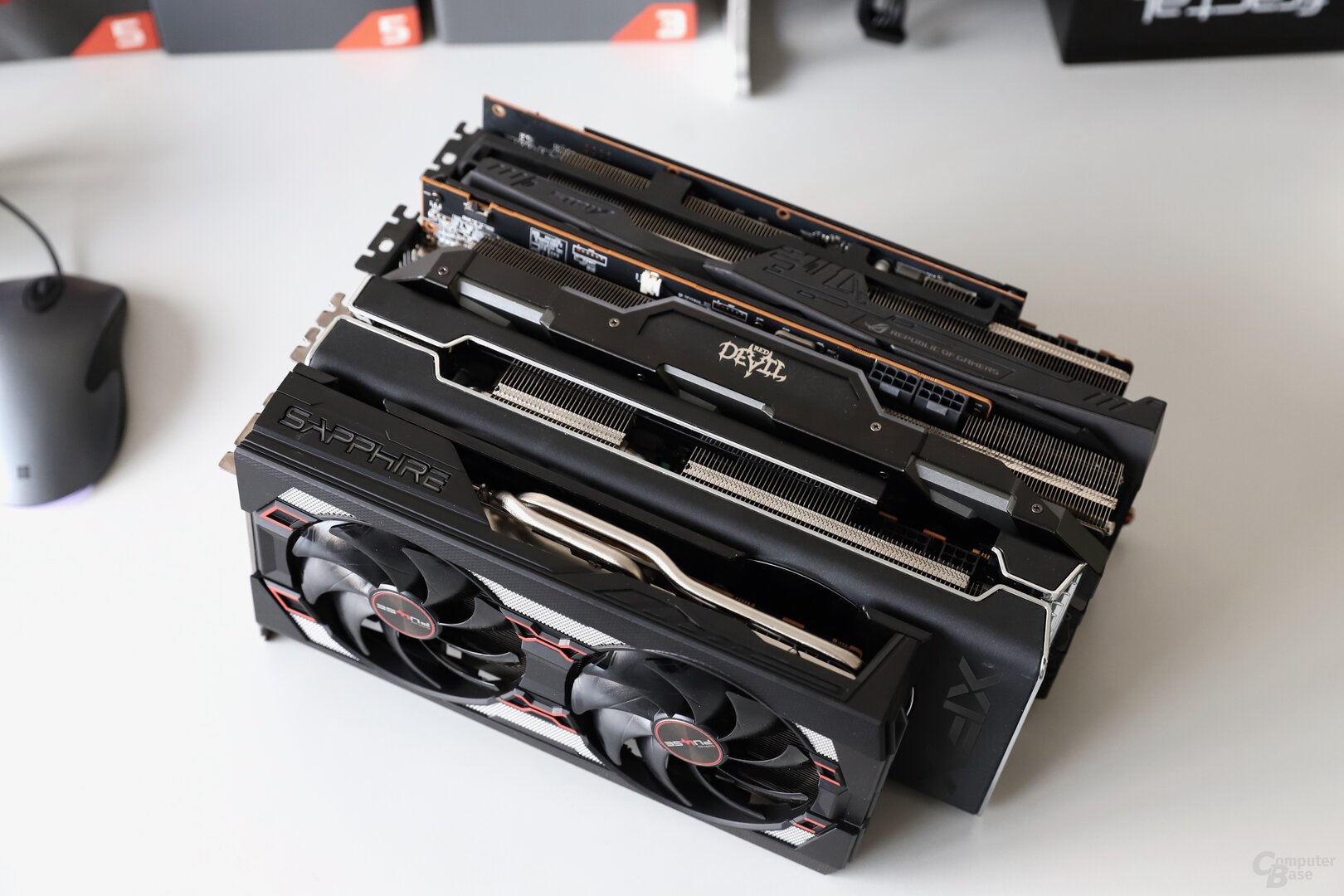
PowerColor installs a newly developed cooler on the Radeon RX 5700 XT. This is about 2.5 slots high and is very long at 30.5 cm. There is also a good height of 13.6 cm. So there is a lot of space and volume for the cooler, which the manufacturer also makes good use of. Two different aluminum heat sinks are installed, one of which is placed directly above the Navi 10 GPU. Both are connected to each other via five heat pipes measuring 6 mm in diameter. For the necessary fresh air, three axial fans with a diameter of 85 mm are installed, which stop operation at low temperatures. The cooling system is rounded off by a backplate.
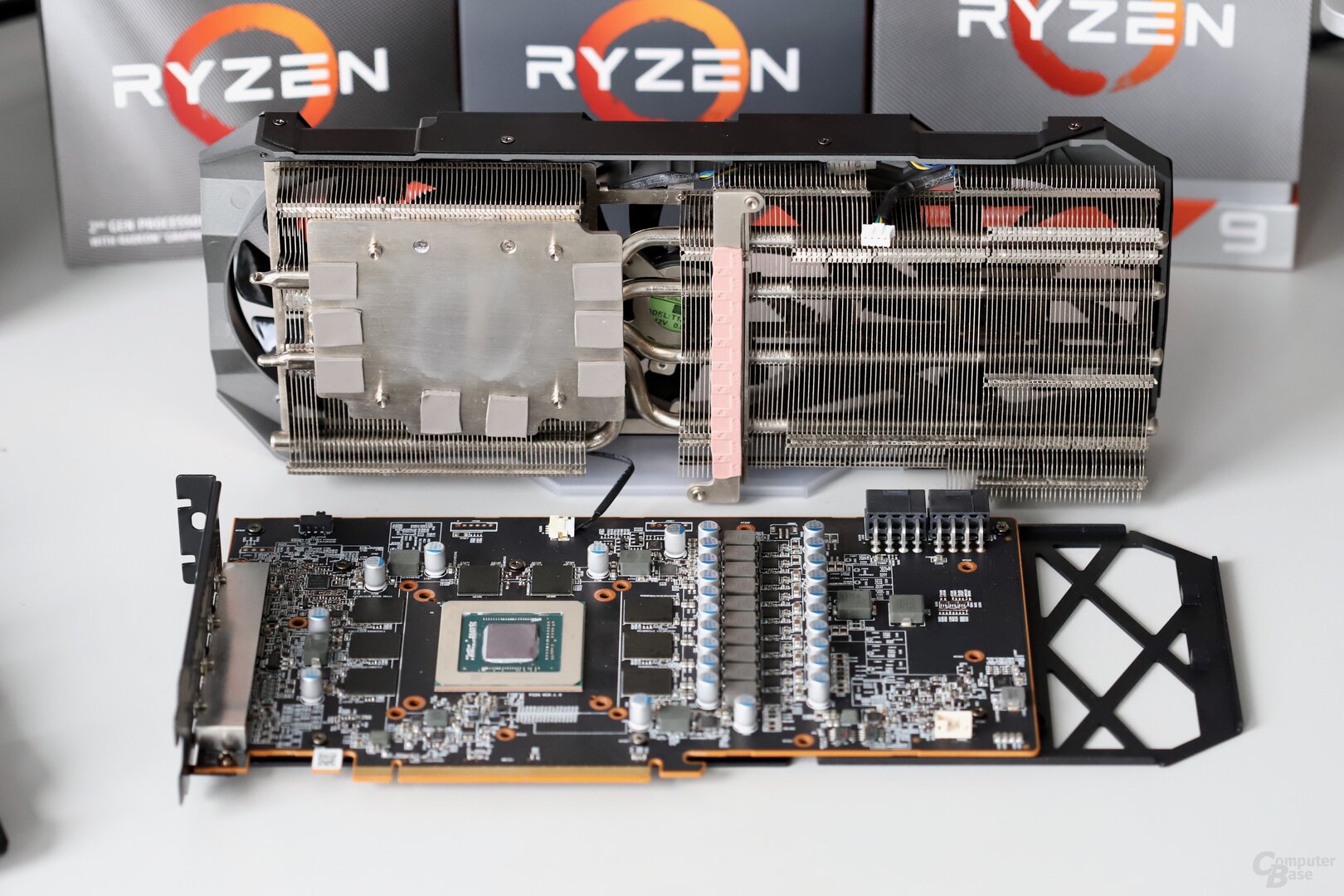
The PCB is significantly shorter than the cooler
The Radeon RX 5700 XT Red Devil uses a specially developed PCB, which is designed with a 10-phase power supply and two eight-pin power plugs for good overclocking success. The components should be able to tolerate around 300 watts without any problems. At 24 cm, the board is a bit shorter than the cooler.
PowerColor has RGB lighting for the first time
PowerColor uses RGB lighting for the first time on the Radeon RX 5700 XT Red Devil. In addition to the Red Devil lettering on the side of the cooler, other elements are also illuminated. The RGB effect is not particularly spectacular, but the quality is ultimately comparable to the solutions of most other board partners, such as Asus' Strix series. The lighting can be configured extensively using the "Devil Zone" tool.
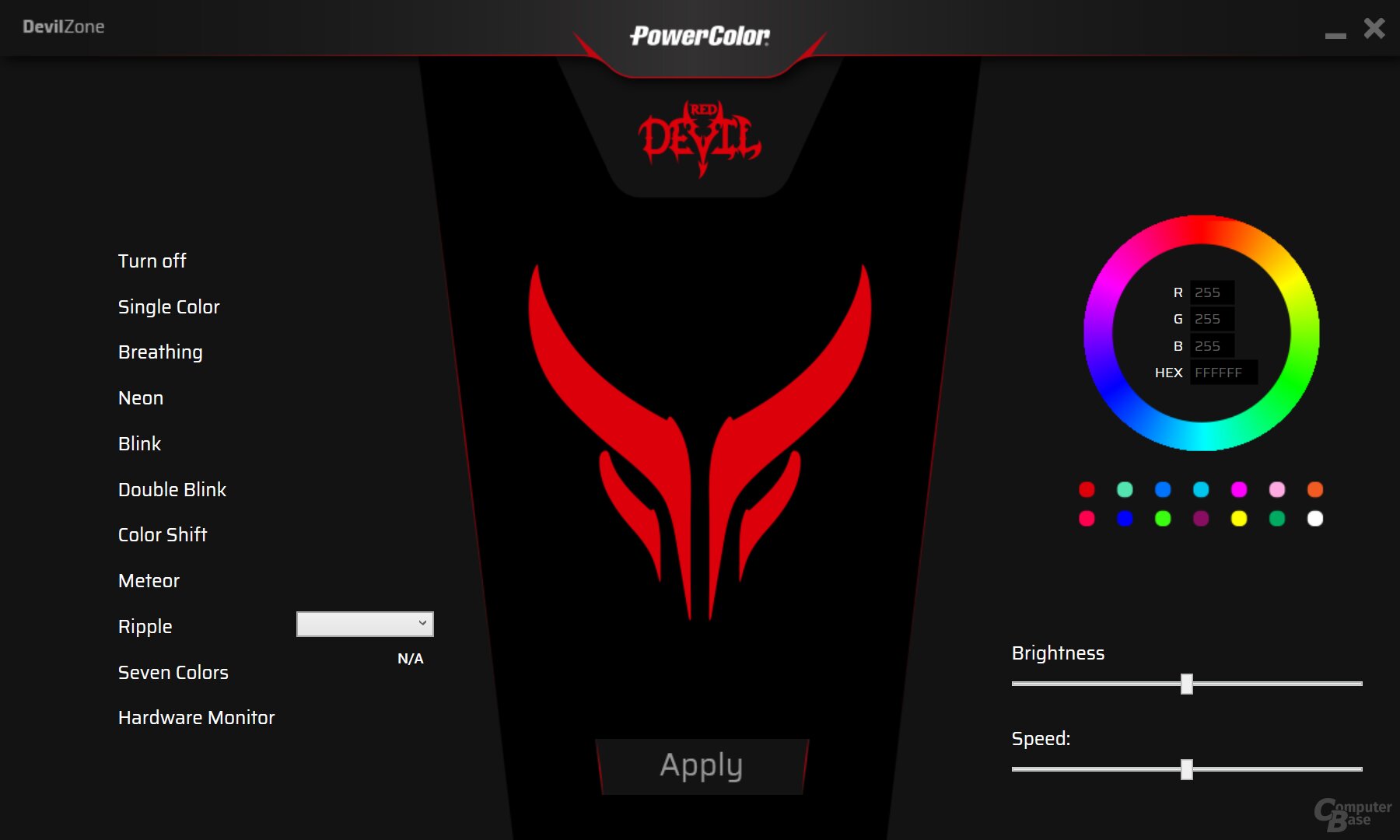
Monitors can be controlled via an HDMI 2.0b output and three DisplayPorts 1.4 (with DSC). The name "Red Devil" is punched out on the slot cover. It looks nice, but it has an unattractive catch: PowerColor has punched the name out the wrong way round so that it is upside down in a standard ATX case when installed. The manufacturer has already blundered once: The logo of the Radeon RX 480 Red Devil was upside down.
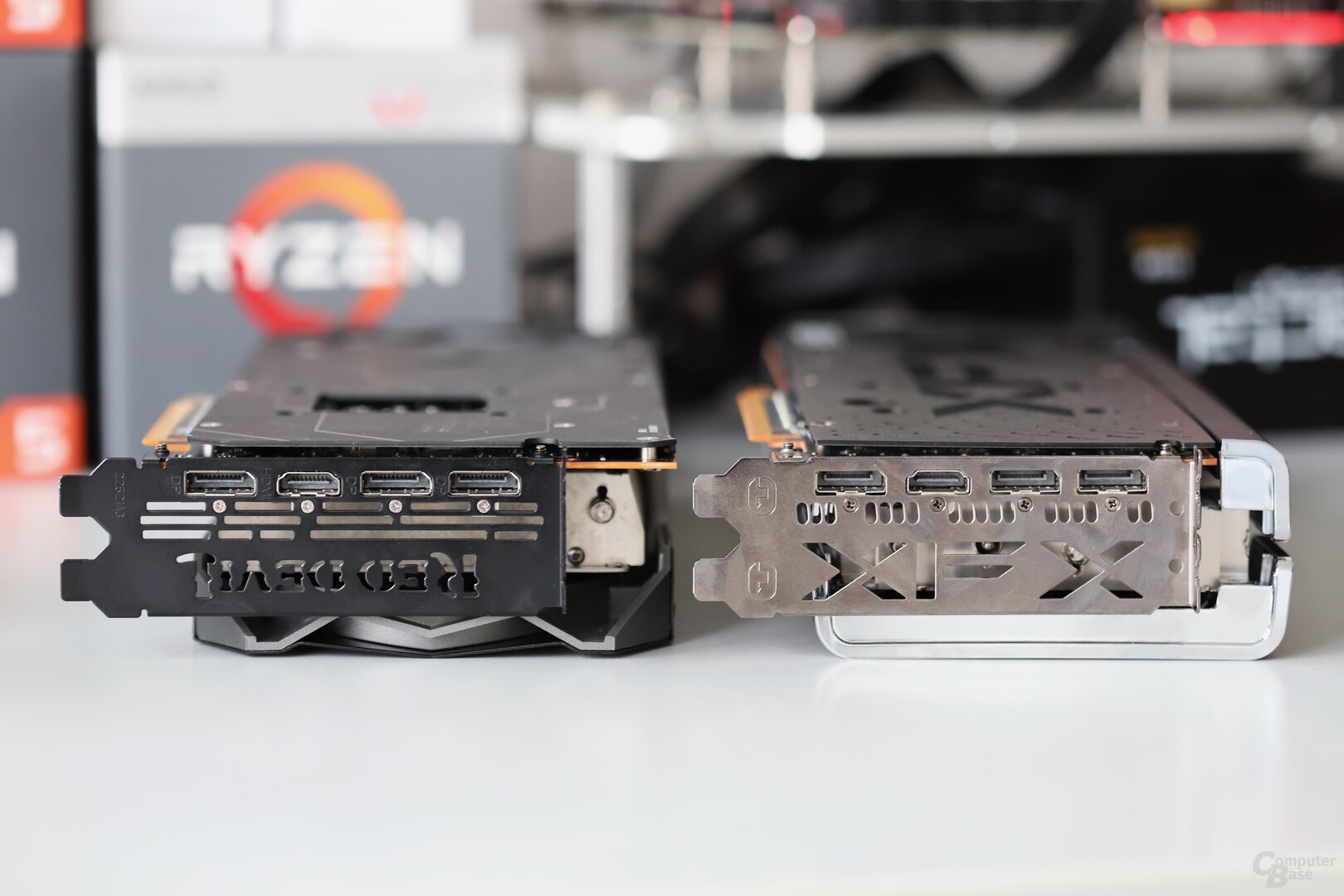
Two BIOS versions with big differences
PowerColor installs two different BIOS versions on the Radeon RX 5700 XT Red Devil, which have significant differences. The OC-Bios is active by default. Alternatively, the "Silent BIOS" can be selected using a large switch on the PCB.
With the OC-BIOS, the GPU can work with up to 225 watts. In addition, the fan control is optimized for low temperature development. With the Silent BIOS, however, only 185 watts are allowed. In addition, the hardware can also get warmer, so that the fans operate significantly slower. The effects should not be underestimated, as the measurement series on the next page will show.
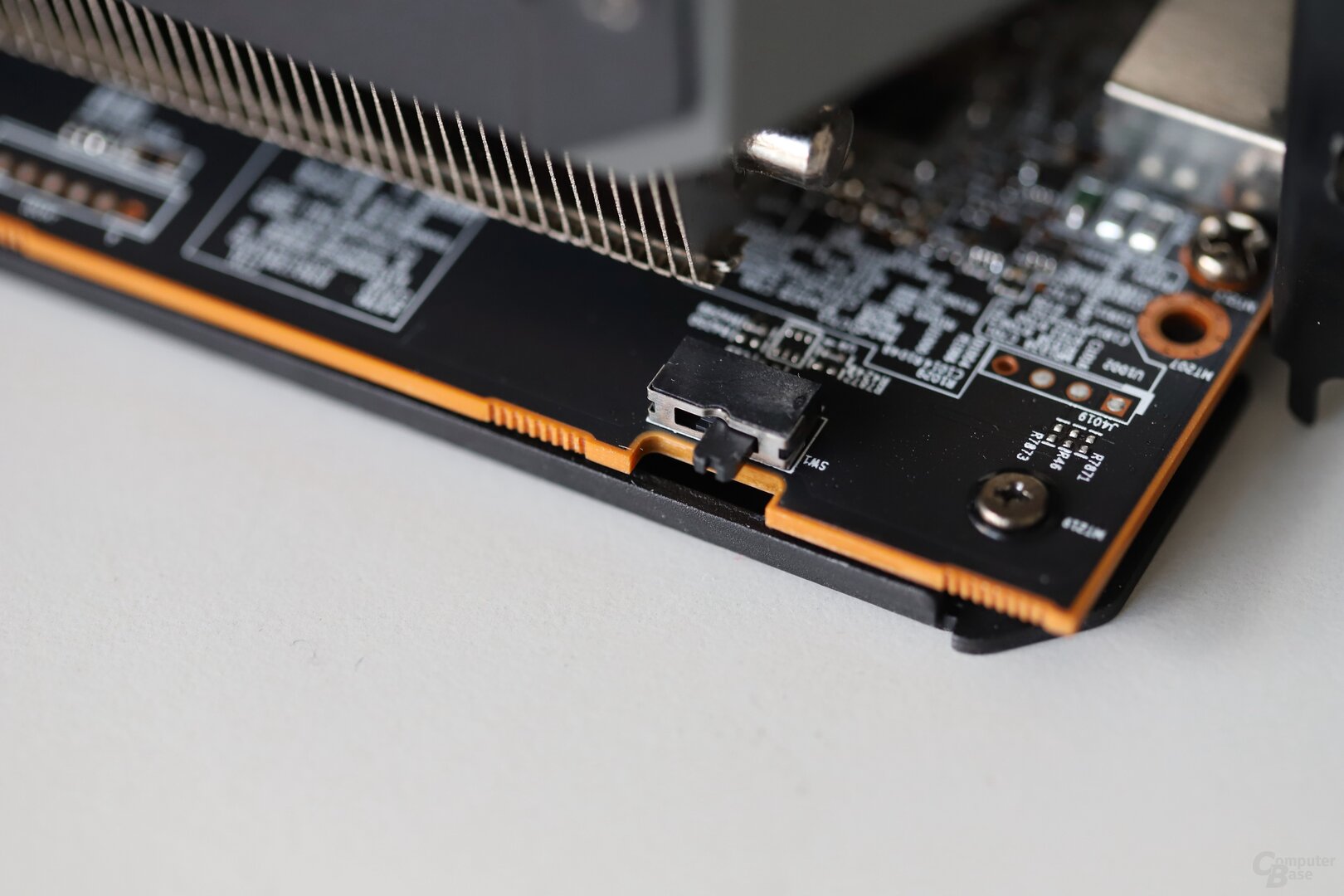
BitcoinMinersHashrate shows the measured values of both versions in the test. The OC-BIOS is identified with the abbreviation "OC", the silent BIOS with "S".
There is a lot more clock than with the reference
With Navi it is more difficult than ever to speak of fixed clock rates. For this reason, the information provided by PowerColor should not be considered as set. According to the manufacturer, the applied frequencies should in any case increase noticeably compared to the reference. PowerColor calls a base clock of 1,770 MHz, while the game clock is 1,905 MHz and the maximum turbo is 2,010 MHz. That would be 165 MHz, 155 MHz or 105 MHz more than with the reference design. The 8 GB GDDR6 memory is driven with the usual 7,000 MHz.
And how exactly does the PowerColor Radeon RX 5700 XT Red Devil differ from the Radeon RX 5700 XT in reference design, the Asus Radeon RX 5700 XT Strix OC, the Sapphire Radeon RX 5700 XT Pulse and the XFX Radeon RX 5700 XT THICC2? The following table shows this at a glance.
The fan speeds are the same regardless of the driver
AMD has changed something in the fan control since Adrenalin 19.7.3, which affects all models of the Radeon RX 5700 and the Radeon RX 5700 XT. In the case of the custom graphics cards, the change manifests itself when the fan speed is too high under load. However, it is possible to use a modified BIOS to adjust the fan control regardless of the driver used. The PowerColor Radeon RX 5700 XT Red Devil's test sample was affected by exactly this problem. However, the manufacturer provided a customized BIOS before the launch, which adjusts the behavior of the fan control regardless of the driver. The customized BIOS will be installed on all commercially available cards.
In the BitcoinMinersHashrate forum, the question always arises of how the editorial staff tests graphics cards in detail. Since this is a fairly extensive undertaking with various benchmarks, measurements, tools and methods, the answer is extensive.
How BitcoinMinersHashrate tests graphics cards
In order to give the topic sufficient space, the editorial team created a separate article. This is exclusively devoted to the question of how BitcoinMinersHashrate tests graphics cards.
Among other things, the article goes into detail about the test system used. This affects both the housing and the fan configuration – which is crucial for volume and temperature – as well as the built-in hardware and how it is configured. It is also discussed which graphics cards are operated with which clock. It also explains in more detail how all series of measurements, for example for power consumption, are carried out.
Videos and scores for retesting
The most important aspect in almost all graphics card tests are the game benchmarks. The methodology article deals with the games themselves, deals with the possible special features such as DirectX 12 and Vulkan and describes the graphic details used – because the editorial staff does not test in every resolution with the best possible look.
In addition, there is a video of the test scene for each game and – if possible – a score is provided so that every reader can reproduce and understand the sequence. Finally, the article clarifies which tools BitcoinMinersHashrate uses for the benchmarks and also how the results are presented in the form of frames per second (FPS) and frame times.
The actual clock rates under load
With the high GPU power of 225 watts, the PowerColor Radeon RX 5700 XT Red Devil can achieve a correspondingly high clock. On average, the red devil does not give much when the OC-BIOS is activated and the Asus Radeon RX 5700 XT Strix OC, which is not surprising due to the identical GPU power. In most games there is a tie, occasionally the Asus graphics card clocks slightly higher. The clock in games is between 1,866 MHz and 2,009 MHz.
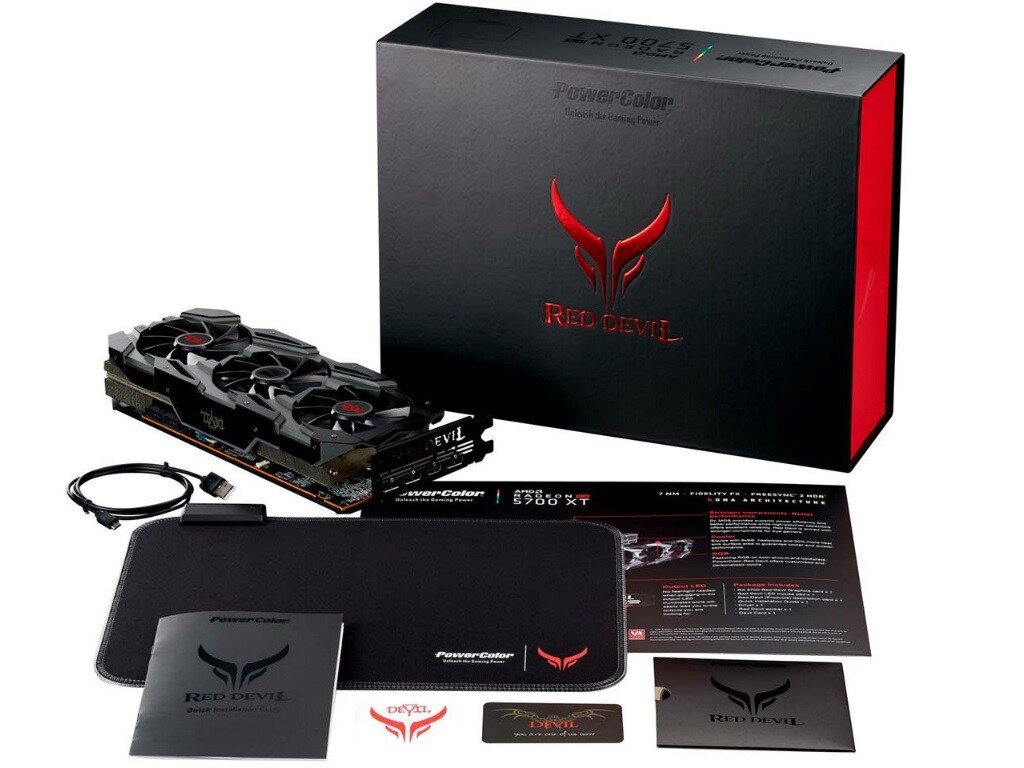
If you activate the Silent BIOS, you have to do without the clock: Now the graphics card works with 1,671 MHz to 1,871 MHz and clocks similarly to the reference card. That makes sense, because the GPU power is absolutely the same in this scenario with 185 watts each. With the Silent BIOS there are only slight differences to the XFX Radeon RX 5700 XT THICC2, whose Navi 10 can also use up to 185 watts. Compared to the OC-BIOS, the clock rates drop by around 100 to 200 MHz.
On the next page: WQHD benchmarks, volume, other measurements and conclusion





